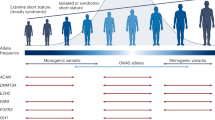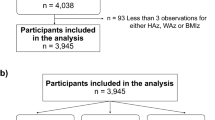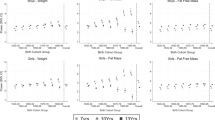Abstract
Background:
Human growth is traditionally envisaged as a target-seeking process regulated by genes, nutrition, health, and the state of an individual’s social and economic environment; it is believed that under optimal physical conditions, an individual will achieve his or her full genetic potential.
Methods:
Using a panel data set on individual height increments, we suggest a statistical modeling approach that characterizes growth as first-order trend stationary and allows for controlling individual growth tempo via observable measures of individual maturity. A Bayesian framework and corresponding Markov-chain Monte Carlo techniques allowing for a conceptually stringent treatment of missing values are adapted for parameter estimation.
Results:
The model provides evidence for the adjustment of the individual growth rate toward average height of the population.
Conclusion:
The increase in adult body height during the past 150 y has been explained by the steady improvement of living conditions that are now being considered to have reached an optimum in Western societies. The current investigation questions the notion that the traditional concept in the understanding of this target-seeking process is sufficient. We consider an additional regulator that possibly points at community-based target seeking in growth.
Similar content being viewed by others
Log in or create a free account to read this content
Gain free access to this article, as well as selected content from this journal and more on nature.com
or
References
Tanner JM . Growth as a target-seeking function: catch-up and catch-down growth in man. In: Falkner F, ed. Human Growth: A Comprehensive Treatment. New York, London: Plenum Press, 1986:167–79.
Fogel RW . The Escape From Hunger and Premature Death, 1700-2100. Cambridge, New York, Melbourne: Cambridge University Press, 2004.
Komlos J . Height and social status in eighteenth-century Germany. J Interdisc His 1990;20:607–21.
van Wieringen JC . Secular growth changes. In: Falkner F, ed. Human Growth: A Comprehensive Treatment. New York, London: Plenum Press, 1986:307–31.
Fredriks AM, van Buuren S, Burgmeijer RJ, et al. Continuing positive secular growth change in The Netherlands 1955-1997. Pediatr Res 2000;47:316–23.
Staub K, Ruhli FJ, Woitek U, Pfister C . The average height of 18- and 19-year-old conscripts (n=458,322) in Switzerland from 1992 to 2009, and the secular height trend since 1878. Schweiz Med Wochenschr 2011;141:w13238.
Pirquet C . Eine einfache Tafel zur Bestimmung von Wachstum und Ernährungszustand bei Kindern (A simple table for determining growth and nutritional status in children). Z Kinderheilkd 1913;O. VI:253–62.
Rosario AS, Schienkiewitz A, Neuhauser H . German height references for children aged 0 to under 18 years compared to WHO and CDC growth charts. Ann Hum Biol 2011;38:121–30.
Tanner JM, Whitehouse RH, Marshall WA, Healy MJR, Goldstein H . Assessment of Skeletal Maturity and Prediction of Adult Height (TW2 Method). London, New York, Paris, San Diego, San Francisco, Sidney, Tokyo, and Toronto: Academic Press, 1983.
Hermanussen M . Auxology: an update. Horm Res Paediatr 2010;74:153–64.
Brundtland GH, Liestøl K, Walløe L . Height, weight and menarcheal age of Oslo schoolchildren during the last 60 years. Ann Hum Biol 1980;7:307–22.
HAGEN W . [On the problem of acceleration]. Dtsch Med Wochenschr 1961;86:220–3.
Aswani N, Taylor CJ, McGaw J, Pickering M, Rigby AS . Pubertal growth and development in cystic fibrosis: a retrospective review. Acta Paediatr 2003;92:1029–32.
Wiedemann B, Steinkamp G, Sens B, Stern M ; German Cystic Fibrosis Quality Assurance Group. The German cystic fibrosis quality assurance project: clinical features in children and adults. Eur Respir J 2001;17:1187–94.
Bogin B, Smith P, Orden AB, Varela Silva MI, Loucky J . Rapid change in height and body proportions of Maya American children. Am J Hum Biol 2002;14:753–61.
Muñoz-Hoyos A, Molina-Carballo A, Augustin-Morales M, et al. Psychosocial dwarfism: psychopathological aspects and putative neuroendocrine markers. Psychiatry Res 2011;188:96–101.
Ryan ND, Dahl RE, Birmaher B, et al. Stimulatory tests of growth hormone secretion in prepubertal major depression: depressed versus normal children. J Am Acad Child Adolesc Psychiatry 1994;33:824–33.
Albertsson-Wikland K, Aronson AS, Gustafsson J, et al. Dose-dependent effect of growth hormone on final height in children with short stature without growth hormone deficiency. J Clin Endocrinol Metab 2008;93:4342–50.
Kumari M, Tabassum F, Clark C, Strachan D, Stansfeld S, Power C . Social differences in insulin-like growth factor-1: findings from a British birth cohort. Ann Epidemiol 2008;18:664–70.
Sapolsky RM, Spencer EM . Insulin-like growth factor I is suppressed in socially subordinate male baboons. Am J Physiol 1997;273(4 Pt 2):R1346–51.
Prader A, Largo RH, Molinari L, Issler C . Physical growth of Swiss children from birth to 20 years of age. Helv Paediatr Acta 1989;43:1–125.
Butler GE, McKie M, Ratcliffe SG . The cyclical nature of prepubertal growth. Ann Hum Biol 1990;17:177–98.
Prader A . Catch-up growth. Postgrad Med J 1978;54:Suppl 1:133–46.
Hermanussen M, Largo RH, Molinari L . Canalisation in human growth: a widely accepted concept reconsidered. Eur J Pediatr 2001;160:163–7.
Geweke J . Using simulation methods for Bayesian econometric models: inference, development, and communication. Econ Rev 1999;18:1–73.
Tanner M, Wong W . The calculation of posterior distributions by data augmentation. J Am Stat Assoc 1987;82:528–40.
Chib S . Marginal likelihood from the Gibbs output. J Am Stat Assoc 1995;90:1313–21.
Acknowledgements
We gratefully acknowledge the generosity of Luciano Molinari, Zurich, Switzerland, from whom we received the data of the First Zurich Longitudinal Growth Study.
Author information
Authors and Affiliations
Corresponding author
Supplementary information
Supplementary Appendix S1
(DOC 1125 kb)
Rights and permissions
About this article
Cite this article
Aßmann, C., Hermanussen, M. Modeling determinants of growth: evidence for a community-based target in height?. Pediatr Res 74, 88–95 (2013). https://doi.org/10.1038/pr.2013.50
Received:
Accepted:
Published:
Issue date:
DOI: https://doi.org/10.1038/pr.2013.50
This article is cited by
-
The association of weight, weight variability and socioeconomic situation among children
European Journal of Clinical Nutrition (2016)
-
Modelling human height and weight: a Bayesian approach towards model comparison
European Journal of Clinical Nutrition (2016)
-
Different effects of living conditions on the variation in BMI and height in children before the onset of puberty
European Journal of Clinical Nutrition (2016)
-
Monte Carlo simulation of body height in a spatial network
European Journal of Clinical Nutrition (2016)
-
Height and skeletal morphology in relation to modern life style
Journal of Physiological Anthropology (2015)



